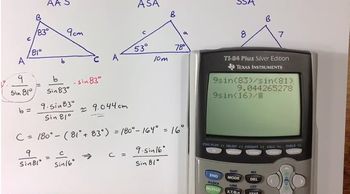Table of contents
- 0. Review of College Algebra4h 43m
- 1. Measuring Angles39m
- 2. Trigonometric Functions on Right Triangles2h 5m
- 3. Unit Circle1h 19m
- 4. Graphing Trigonometric Functions1h 19m
- 5. Inverse Trigonometric Functions and Basic Trigonometric Equations1h 41m
- 6. Trigonometric Identities and More Equations2h 34m
- 7. Non-Right Triangles1h 38m
- 8. Vectors2h 25m
- 9. Polar Equations2h 5m
- 10. Parametric Equations1h 6m
- 11. Graphing Complex Numbers1h 7m
7. Non-Right Triangles
Law of Sines
Problem 30
Textbook Question
In Exercises 17–32, two sides and an angle (SSA) of a triangle are given. Determine whether the given measurements produce one triangle, two triangles, or no triangle at all. Solve each triangle that results. Round to the nearest tenth and the nearest degree for sides and angles, respectively. a = 95, c = 125, A = 49°
 Verified step by step guidance
Verified step by step guidance1
<Step 1: Identify the given information. You have side a = 95, side c = 125, and angle A = 49°. This is an SSA (Side-Side-Angle) case.>
<Step 2: Use the Law of Sines to find angle C. The Law of Sines states: \( \frac{a}{\sin A} = \frac{c}{\sin C} \). Substitute the known values into the equation.>
<Step 3: Solve for \( \sin C \) using the equation from Step 2. Calculate \( \sin C = \frac{c \cdot \sin A}{a} \).>
<Step 4: Determine the possible values for angle C. If \( \sin C \) is greater than 1, no triangle exists. If \( \sin C \) is less than or equal to 1, calculate angle C using \( C = \sin^{-1}(\sin C) \). Consider the possibility of two triangles if \( \sin C \) is less than 1.>
<Step 5: Use the calculated angle C to find angle B and side b. For one triangle, use \( B = 180° - A - C \) and the Law of Sines to find b. For two triangles, calculate the second possible angle C as \( 180° - C \) and repeat the process to find the second set of angles and side.>
Recommended similar problem, with video answer:
 Verified Solution
Verified SolutionThis video solution was recommended by our tutors as helpful for the problem above
Video duration:
9mPlay a video:
Was this helpful?
Key Concepts
Here are the essential concepts you must grasp in order to answer the question correctly.
Law of Sines
The Law of Sines relates the ratios of the lengths of sides of a triangle to the sines of its opposite angles. It is expressed as a/b = sin(A)/sin(B) = c/sin(C). This law is particularly useful in SSA (Side-Side-Angle) cases, allowing us to determine unknown angles and sides when two sides and a non-included angle are known.
Recommended video:

Intro to Law of Sines
Ambiguous Case of SSA
The SSA condition can lead to an ambiguous situation where one, two, or no triangles can be formed. This occurs because the given angle and side lengths may not uniquely determine a triangle. Understanding this ambiguity is crucial for correctly identifying the number of possible triangles and solving for their dimensions.
Recommended video:

Solving SSA Triangles ("Ambiguous" Case)
Triangle Sum Theorem
The Triangle Sum Theorem states that the sum of the interior angles of a triangle is always 180 degrees. This theorem is essential for solving triangles, as it allows us to find unknown angles once we have determined some angles using the Law of Sines, ensuring that the triangle's angle measures are valid.
Recommended video:

Solving Right Triangles with the Pythagorean Theorem

 4:27m
4:27mWatch next
Master Intro to Law of Sines with a bite sized video explanation from Patrick Ford
Start learningRelated Videos
Related Practice
















